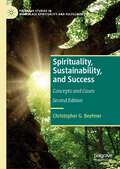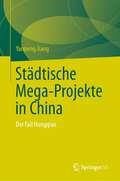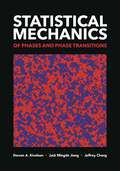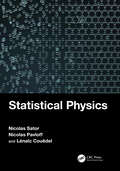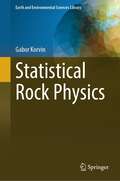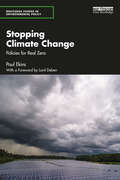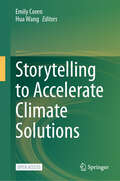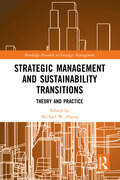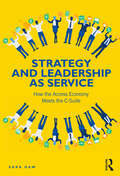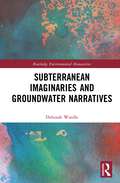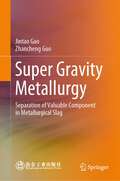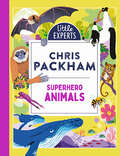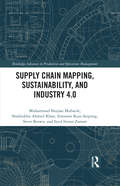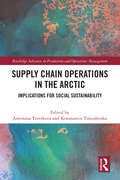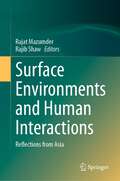- Table View
- List View
Spirituality, Sustainability, and Success: Concepts and Cases (Palgrave Studies in Workplace Spirituality and Fulfillment)
by Christopher G. BeehnerThis book offers a pragmatic approach to the benefits of spirituality and sustainability for both individual and organizational success. It introduces sustainability and workplace spirituality as contemporary solutions to the challenging organizational environment. The first few chapters introduce the fundamentals of spirituality, workplace spirituality, and sustainability. The author then demonstrates how the three qualities are beneficial in achieving personal and business success. Through the combination of synthesized research summaries and case studies of individuals and organizations, this book offers readers a fresh perspective on the importance of spirituality and sustainability to organizational performance.
Städtische Mega-Projekte in China: Der Fall Hongqiao
by Yanpeng JiangDieses Buch ist die erste systematische Darstellung von städtischen Megaprojekten in China, die sich mit deren Bau, Betrieb und Planung befasst. Es ist eine detaillierte Untersuchung der Planung und des Baus von Hongqiao und seiner Auswirkungen auf die Anwohner. Kurz gesagt, das Ziel dieses Buches ist es, den Planungs- und Entwicklungsprozess der Verkehrs- und Handelszone Hongqiao zu untersuchen, ihre Beziehung zur Stadtentwicklung und zur räumlichen Umstrukturierung in Shanghai zu erforschen und dabei die Art des städtischen Wandels im heutigen China zu kommentieren und zu kritisieren, der als eigentums- und infrastrukturgetrieben charakterisiert wird. Städtische Megaprojekte sind wohl das Symbol des unternehmerischen Urbanismus schlechthin, und es ist kein Zufall, dass sie in der ganzen Welt, nicht zuletzt in Ostasien, zu einem vertrauten Bestandteil der städtischen Szene geworden sind. Sie können sowohl als Folge der Deindustrialisierung führender Städte, zunächst in Nordamerikaund Europa und dann in Ostasien, als Reaktion auf den Übergang der Volkswirtschaften zum globalisierten Neoliberalismus betrachtet werden. Dieses Buch bietet einen umfassenden Überblick über die Hauptmerkmale der in Hongqiao gebildeten landbasierten städtischen Wachstumskoalition, indem es das Hongqiao-Projekt im Detail vorstellt und das jüngste Beispiel des wettbewerbsorientierten Ansturms auf städtische Projekte in Chinas größten Städten skizziert, der zur Ausbreitung neuer Finanzdistrikte in Beijing und Guangzhou geführt hat.
Statistical Mechanics of Phases and Phase Transitions
by Steven A. Kivelson Jack Mingde Jiang Jeffrey ChangAn engaging undergraduate introduction to the statistical mechanics of phase transitionsStatistical mechanics deploys a powerful set of mathematical approaches for studying the thermodynamic properties of complex physical systems. This textbook introduces students to the statistical mechanics of systems undergoing changes of state, focusing on the basic principles for classifying distinct thermodynamic phases and the critical phenomena associated with transitions between them. Uniquely designed to promote active learning, Statistical Mechanics of Phases and Phase Transitions presents some of the most beautiful and profound concepts in physics, enabling students to obtain an essential understanding of a computationally challenging subject without getting lost in the details.Provides a self-contained, conceptually deep introduction to the statistical mechanics of phases and phase transitions from a modern perspectiveCarefully leads students from spontaneously broken symmetries to the universality of phase transitions and the renormalization groupEncourages student-centric active learning suitable for both the classroom and self-studyFeatures a wealth of guided worksheets with full solutions throughout the book that help students learn by doingIncludes informative appendixes that cover key mathematical concepts and methodsIdeal for undergraduate physics majors and beginning graduate studentsSolutions manual for all end-of-chapter problems (available only to instructors)
Statistical Physics
by Nicolas Sator Nicolas Pavloff Lenaic CouedelThis book presents an introduction to the main concepts of statistical physics, followed by applications to specific problems and more advanced concepts, selected for their pedagogical or practical interest. Particular attention has been devoted to the presentation of the fundamental aspects, including the foundations of statistical physics, as well as to the discussion of important physical examples. Comparison of theoretical results with the relevant experimental data (with illustrative curves) is present through the entire textbook. This aspect is facilitated by the broad range of phenomena pertaining to statistical physics, providing example issues from domains as varied as the physics of classical and quantum liquids, condensed matter, liquid crystals, magnetic systems, astrophysics, atomic and molecular physics, superconductivity and many more. This textbook is intended for graduate students (MSc and PhD) and for those teaching introductory or advanced courses on statistical physics. Key Features: A rigorous and educational approach of statistical physics illustrated with concrete examples. A clear presentation of fundamental aspects of statistical physics. Many exercises with detailed solutions. Nicolas Sator is Associate Professor at Sorbonne University, Paris, France. He is a member of the Laboratory of Theoretical Physics of Condensed Matter (LPTMC) and his research focuses on the physics of liquids. Nicolas Pavloff is Professor at Paris-Saclay University, France. He is a member of Laboratoire de Physique Théorique et Modèles Statistiques (LPTMS) and his domain of research is quantum fluid theory. Lénaïc Couëdel is Professor at the University of Sasktchewan, Saskatoon, Canada and researcher at CNRS, France. His research area is plasma physics with a focus on complex plasma crystals.
Statistical Physics
by Nicolas Sator Nicolas Pavloff Lenaic CouedelThis book presents an introduction to the main concepts of statistical physics, followed by applications to specific problems and more advanced concepts, selected for their pedagogical or practical interest. Particular attention has been devoted to the presentation of the fundamental aspects, including the foundations of statistical physics, as well as to the discussion of important physical examples. Comparison of theoretical results with the relevant experimental data (with illustrative curves) is present through the entire textbook. This aspect is facilitated by the broad range of phenomena pertaining to statistical physics, providing example issues from domains as varied as the physics of classical and quantum liquids, condensed matter, liquid crystals, magnetic systems, astrophysics, atomic and molecular physics, superconductivity and many more. This textbook is intended for graduate students (MSc and PhD) and for those teaching introductory or advanced courses on statistical physics. Key Features: A rigorous and educational approach of statistical physics illustrated with concrete examples. A clear presentation of fundamental aspects of statistical physics. Many exercises with detailed solutions. Nicolas Sator is Associate Professor at Sorbonne University, Paris, France. He is a member of the Laboratory of Theoretical Physics of Condensed Matter (LPTMC) and his research focuses on the physics of liquids. Nicolas Pavloff is Professor at Paris-Saclay University, France. He is a member of Laboratoire de Physique Théorique et Modèles Statistiques (LPTMS) and his domain of research is quantum fluid theory. Lénaïc Couëdel is Professor at the University of Sasktchewan, Saskatoon, Canada and researcher at CNRS, France. His research area is plasma physics with a focus on complex plasma crystals.
Statistical Rock Physics (Earth and Environmental Sciences Library)
by Gabor KorvinThe book is the first systematic and comprehensive treatise of stochastic models and computational tools that have emerged in rock-physics in the last 20 years. The field of statistical rock-physics is a part of rock-physics (Petrophysics). Its concepts, methods and techniques are borrowed from stochastic geometry and statistical physics. This discipline describes the interior geometry of rocks; derives their effective physical properties based on their random composition and the random arrangement of their constituents; and builds models to simulate the past geological processes that had formed the rock. The aim of the book is to help the readers to understand the claims, techniques and published results of this new field and—most importantly—to teach them in order to creatively apply stochastic geometry and statistical physics in their own research tasks. For this purpose, the underlying mathematics will be discussed in all sections of the book; numerical solutions will be highlighted; a full set of references will be provided; and theory will go hand-in-hand with practical applications to hydraulic permeability, electric conduction, rock failure, NMR, mechanics of random grain packings, as well as the compaction of shale.
Stopping Climate Change: Policies for Real Zero (Routledge Studies in Environmental Policy)
by Paul EkinsWritten by one of the leading experts in the field, Paul Ekins, Stopping Climate Change provides a comprehensive overview of what is required to achieve ‘real zero’ carbon dioxide emissions by 2050, and negative emissions thereafter, which is the only way to stop human- induced climate change.This will require innovation in socio-technical systems, and in human behaviour, on an unprecedented scale. Stopping Climate Change describes the changes required to meet this goal: in technologies, social institutions and individual activities. Paul Ekins examines in detail issues around the supply and demand of energy and materials, and the efficiency of their use. It also analyses greenhouse gas removal technologies, offsetting and geoengineering, and plots the reduction of the non- CO2 greenhouse gas-emitting activities. Having set out the changes required, Ekins considers the economic implications, in terms of both the innovation and investments that are necessary to bring them about, and the effects that these are likely to have on national economies. The evidence presented points clearly to the economic impacts of decarbonisation being positive for the majority of countries, and for the world as a whole, even before considering the benefits of avoided climate change. When the health benefits of stopping the burning of fossil fuels are factored in, the global net benefits of decarbonisation are unequivocal.Drawing on examples from the UK and Europe, but with wider relevance at a global scale, Stopping Climate Change clearly shows how determined policy action at different levels could stop climate change. It will be of great interest to students, scholars and policymakers researching and working in the field of climate change and energy policy.
Stopping Climate Change: Policies for Real Zero (Routledge Studies in Environmental Policy)
by Paul EkinsWritten by one of the leading experts in the field, Paul Ekins, Stopping Climate Change provides a comprehensive overview of what is required to achieve ‘real zero’ carbon dioxide emissions by 2050, and negative emissions thereafter, which is the only way to stop human- induced climate change.This will require innovation in socio-technical systems, and in human behaviour, on an unprecedented scale. Stopping Climate Change describes the changes required to meet this goal: in technologies, social institutions and individual activities. Paul Ekins examines in detail issues around the supply and demand of energy and materials, and the efficiency of their use. It also analyses greenhouse gas removal technologies, offsetting and geoengineering, and plots the reduction of the non- CO2 greenhouse gas-emitting activities. Having set out the changes required, Ekins considers the economic implications, in terms of both the innovation and investments that are necessary to bring them about, and the effects that these are likely to have on national economies. The evidence presented points clearly to the economic impacts of decarbonisation being positive for the majority of countries, and for the world as a whole, even before considering the benefits of avoided climate change. When the health benefits of stopping the burning of fossil fuels are factored in, the global net benefits of decarbonisation are unequivocal.Drawing on examples from the UK and Europe, but with wider relevance at a global scale, Stopping Climate Change clearly shows how determined policy action at different levels could stop climate change. It will be of great interest to students, scholars and policymakers researching and working in the field of climate change and energy policy.
Storytelling to Accelerate Climate Solutions
by Hua Wang Emily CorenThe climate is changing faster than our cultural practices are adapting to it. This Open Access volume, co-edited by Emily Coren (a science communicator) and Hua Wang (a communication scientist), presents a survey of the latest in agency-focused climate storytelling. Together, practitioners and scholars across different fields shared their knowledge, experience, and insight about how stories can be designed and told to engage, enable, and empower individuals and communities in climate communication and action. You will learn a wide range of narrative strategies and exemplary applications of climate storytelling in terms of professional practices (e.g., education, literature, journalism, popular media), genres and formats (e.g., drama, comedy, fiction), media platforms (e.g., television, radio, mobile), and communication modalities (e.g., text, visual, audio, multisensory). Entertainment-education has been proven over decades to be an effective tool for social and behavior change in the public health sphere and has not yet been applied at scale to the massive ongoing climate–related disasters that we need to solve now, fast. There is an urgent need to rapidly apply and adapt public engagement tools for climate communication to speed up our response times for climate change mitigation and adaptation. This book takes a snapshot of where climate storytelling is currently at, describes where it fits within a climate communication landscape, and supports the next steps of its development. It facilitates the of creation climate storytelling efficiently by sharing and amplifying what is working well, and building collaborations between practitioners and researchers.This is an open access book.
Strabo's Geography: A Translation for the Modern World
by StraboA lively new translation of Strabo&’s complete Geography—an encyclopedic guide to the ancient world of the first century CE—connecting it with the world of the twenty-first centuryStrabo&’s Geography is an encyclopedic description of the ancient world as it appeared to a contemporary observer in the early Roman empire. Information about taming elephants, collecting saffron, producing asphalt, and practicing yoga is found alongside accounts of prostitution, volcanic activity, religious festivals, and obscure eastern dynasties—all set against the shifting backdrop of political power in the first century CE. Traveling around the Mediterranean, Strabo gathered knowledge of places and people, supplementing his firsthand experiences with an immense amount of reading to create a sweeping chronicle that attempts to answer the implicit questions &“Who are we?&” and &“Where do we come from?&” Sarah Pothecary&’s new translation of Strabo&’s complete Geography makes this important work more accessible, relevant, and enjoyable than ever before.Conveying the informal, lively, and almost journalistic style of Strabo&’s Greek, this translation connects the ancient and modern worlds by providing modern names and maps for places mentioned in the text, a generous page layout, and marginal notes, allowing readers to appreciate Strabo&’s work directly and immediately. The result mimics what Strabo was doing two thousand years ago—relating the rapidly changing present of his original readers to their own ancient past.A remarkably modern translation of a revealing window on the ancient world, this is essential reading for anyone interested in how we look at both antiquity and the world today.
Strategic Management and Sustainability Transitions: Theory and Practice (Routledge Research in Strategic Management)
by Michael ZhangThe subject of sustainability transitions has, in the past decade or so, become an established research field for academics, policy makers and practitioners alike. Conceptual and theoretical developments in the filed have gradually advanced from the perspectives of socio-technical systems and business models. Scholars contend that it is the interactions of the networks of actors, technologies, and institutions that drive transition processes toward sustainability. In this volume we further advance this line of inquiry with a special reference to strategic management of sustainability transitions, in both theory and practice. In theoretical development, we have selected three chapters to encompass the themes of (1) the interactions between ecological systems and human systems; (2) a critique on the continuous expansion of large multinational companies and their strategic control of key resource inputs through the lenses of circular economy and natural resource-based view; and (3) a multi-stakeholder ecosystems framework for the management of sustainability transitions with structural alignment of focal value propositions. The United Nations’ Sustainable Development Goals (SDGs) are critically addressed and empirically examined. It will become an essential reader and a reference book for researchers and postgraduate students interested in strategic management, international business, innovation studies, consumer behavior, and public administration.
Strategic Management and Sustainability Transitions: Theory and Practice (Routledge Research in Strategic Management)
by Michael ZhangThe subject of sustainability transitions has, in the past decade or so, become an established research field for academics, policy makers and practitioners alike. Conceptual and theoretical developments in the filed have gradually advanced from the perspectives of socio-technical systems and business models. Scholars contend that it is the interactions of the networks of actors, technologies, and institutions that drive transition processes toward sustainability. In this volume we further advance this line of inquiry with a special reference to strategic management of sustainability transitions, in both theory and practice. In theoretical development, we have selected three chapters to encompass the themes of (1) the interactions between ecological systems and human systems; (2) a critique on the continuous expansion of large multinational companies and their strategic control of key resource inputs through the lenses of circular economy and natural resource-based view; and (3) a multi-stakeholder ecosystems framework for the management of sustainability transitions with structural alignment of focal value propositions. The United Nations’ Sustainable Development Goals (SDGs) are critically addressed and empirically examined. It will become an essential reader and a reference book for researchers and postgraduate students interested in strategic management, international business, innovation studies, consumer behavior, and public administration.
Strategy and Leadership as Service: How the Access Economy Meets the C-Suite
by Sara DawStrategy and Leadership as Service isn’t just a nice idea; it is a practical, alternative vision of the future of work for senior executives that is starting to gain significant interest and is being adopted by businesses globally. Disrupting and challenging the traditional full-time employment model, the Strategy and Leadership as Service framework provides businesses with access to the complete range of functional, emotional, and collective intelligence at the C-suite level by moving their positions from the “pay-roll” to an “access-role.”Many entrepreneurial and growing businesses don’t need, don’t want, and can’t afford full-time C-suite executives. For larger organisations, it is becoming harder to find the skills and knowledge required to fulfil all the obligations of a functional C-suite with a fixed group of individuals. By moving to the Strategy and Leadership as Service framework, the outcomes are better for all stakeholders: more engagement, access to the right skillsets and mindsets at the right time and in the right quantity to match the changing business agenda, more flexibility for senior leaders, and strengthened risk management. Through presenting a working business model, and real-world case studies throughout, this book provides executives and leaders with a complete understanding of this ground-breaking approach and its key benefits, the theory upon which it is based, its essential ingredients, the mindset change required and, most importantly, how to apply it in practice.The book provides business leaders, C-suite portfolio executives, human resource professionals, strategy consultants, leadership coaches, organisational development consultants, recruiters, professional service firms, academics, and forward-thinking business students with a radical new view of how the access economy can be applied to business strategy and leadership for more sustainable futures.
Strategy and Leadership as Service: How the Access Economy Meets the C-Suite
by Sara DawStrategy and Leadership as Service isn’t just a nice idea; it is a practical, alternative vision of the future of work for senior executives that is starting to gain significant interest and is being adopted by businesses globally. Disrupting and challenging the traditional full-time employment model, the Strategy and Leadership as Service framework provides businesses with access to the complete range of functional, emotional, and collective intelligence at the C-suite level by moving their positions from the “pay-roll” to an “access-role.”Many entrepreneurial and growing businesses don’t need, don’t want, and can’t afford full-time C-suite executives. For larger organisations, it is becoming harder to find the skills and knowledge required to fulfil all the obligations of a functional C-suite with a fixed group of individuals. By moving to the Strategy and Leadership as Service framework, the outcomes are better for all stakeholders: more engagement, access to the right skillsets and mindsets at the right time and in the right quantity to match the changing business agenda, more flexibility for senior leaders, and strengthened risk management. Through presenting a working business model, and real-world case studies throughout, this book provides executives and leaders with a complete understanding of this ground-breaking approach and its key benefits, the theory upon which it is based, its essential ingredients, the mindset change required and, most importantly, how to apply it in practice.The book provides business leaders, C-suite portfolio executives, human resource professionals, strategy consultants, leadership coaches, organisational development consultants, recruiters, professional service firms, academics, and forward-thinking business students with a radical new view of how the access economy can be applied to business strategy and leadership for more sustainable futures.
Subterranean Imaginaries and Groundwater Narratives (Routledge Environmental Humanities)
by Deborah WardleThis book interrogates the problems of how and why largely unseen matter, in this case groundwater, has found limited expression in climate fiction. It explores key considerations for writing groundwater narratives in the Anthropocene. The book investigates a unique selection of climate fiction alongside an exploration of hydrosocial environmental humanities through a focus on groundwater and groundwater narratives. Providing eco-critical analysis, with creative fiction and non-fiction excerpts interwoven throughout, and drawing on Indigenous Australian and Australian settler novels and poems alongside European, American and Japanese texts, the book illuminates the processes of ‘storying with’ subterranean waters – their facts, uncertainties, potencies and vulnerabilities. In a time when the water crisis in an Australian and worldwide context is escalating in response to global warming, giving voice to the complexities of groundwater extraction and pollution is vital. Drawing from non-representational, posthumanist and feminist perspectives, the book provides an important contribution to transnational, comparative climate fiction analysis, enabling an interdisciplinary exchange between hydrogeological science and the eco-humanities. This book is an engaging read for scholars and students in creative writing, environmental humanities, cultural and post-colonial studies, Australian studies, and eco-critical literary studies. Writers and thinkers addressing the problems of the Anthropocene are called to pay attention to the importance of subterranean imaginaries and groundwater narratives.
Subterranean Imaginaries and Groundwater Narratives (Routledge Environmental Humanities)
by Deborah WardleThis book interrogates the problems of how and why largely unseen matter, in this case groundwater, has found limited expression in climate fiction. It explores key considerations for writing groundwater narratives in the Anthropocene. The book investigates a unique selection of climate fiction alongside an exploration of hydrosocial environmental humanities through a focus on groundwater and groundwater narratives. Providing eco-critical analysis, with creative fiction and non-fiction excerpts interwoven throughout, and drawing on Indigenous Australian and Australian settler novels and poems alongside European, American and Japanese texts, the book illuminates the processes of ‘storying with’ subterranean waters – their facts, uncertainties, potencies and vulnerabilities. In a time when the water crisis in an Australian and worldwide context is escalating in response to global warming, giving voice to the complexities of groundwater extraction and pollution is vital. Drawing from non-representational, posthumanist and feminist perspectives, the book provides an important contribution to transnational, comparative climate fiction analysis, enabling an interdisciplinary exchange between hydrogeological science and the eco-humanities. This book is an engaging read for scholars and students in creative writing, environmental humanities, cultural and post-colonial studies, Australian studies, and eco-critical literary studies. Writers and thinkers addressing the problems of the Anthropocene are called to pay attention to the importance of subterranean imaginaries and groundwater narratives.
Sufficiency in Business: The Transformative Potential of Business for Sustainability (Neue Ökonomie #2)
by Maike Gossen Laura NiessenBusinesses want to be sustainable but how can they promote sufficiency? Sufficiency-oriented business models focus on creating sustainable value, promoting reduced resource consumption and adjusting production volumes to planetary boundaries. The contributors to this volume present real-life examples of sufficiency-oriented companies across diverse industries. These experts share their insights on sufficiency strategies in business, barriers and opportunities discovered, and the impact on customer behavioural change. They address the far-reaching changes in business, society, and policy required for this paradigm shift and suggest future research directions.
Super Gravity Metallurgy: Separation of Valuable Component in Metallurgical Slag
by Jintao Gao Zhancheng GuoThis book introduces super gravity metallurgy in separation of valuable component in metallurgical slag. It collects the principle, apparatus and research for super gravity high-temperature metallurgy and the novel technology for selective crystallization and separation of various valuable components in different metallurgical slags by super gravity. Furthermore, the research results previously scattered in many journals and conferences worldwide are methodically edited and presented in a unified form. The book is likely to be of interest to university teachers, researchers, R&D engineers and graduate students in pyrometallurgy and extractive metallurgy who wish to explore innovative methods and technologies that lead to more efficient and environmentally sustainable utilization of metallurgical slag.
Superhero Animals (Little Experts #Book 6)
by Chris PackhamGet up close to nature with naturalist and TV presenter CHRIS PACKHAM CBE and encounter the amazing animal superheroes that will help us save the world.
Supply Chain Mapping, Sustainability, and Industry 4.0 (Routledge Advances in Production and Operations Management)
by Muhammad Shujaat Mubarik Sharfuddin Ahmed Khan Simonov Kusi-Sarpong Steve Brown Syed Imran ZamanDuring the COVID-19 pandemic, supply chain (SC) mapping appeared as one of the critical SC capabilities that could make a striking difference in organizations’ SC performance and improve sustainable operations. Despite its crucial role in responding to SC disruptions, there is a void in the literature on this topic. This book aims to address this gap demonstrating the importance of SC mapping, sustainability in the Industry 4.0 era. The book explores how SC mapping contributes to sustainability from social, economic, and environmental perspectives, the role of SC mapping in upstream, midstream, and downstream SC sustainability, as well as the role of technology advancement and the impact of blockchain and Industry 4.0 in SC mapping. Adopting a multidisciplinary approach, this edited collection features international authors from a diverse range of disciplines including SC management, operations management, technology and innovation management, and sustainability. The book will be a valuable resource for global scholars, researchers, and upper-level students across operations, SC management, and logistics, as well as engineering and technology management.
Supply Chain Mapping, Sustainability, and Industry 4.0 (Routledge Advances in Production and Operations Management)
by Muhammad Shujaat Mubarik Sharfuddin Ahmed Khan Simonov Kusi-Sarpong Steve Brown Syed Imran ZamanDuring the COVID-19 pandemic, supply chain (SC) mapping appeared as one of the critical SC capabilities that could make a striking difference in organizations’ SC performance and improve sustainable operations. Despite its crucial role in responding to SC disruptions, there is a void in the literature on this topic. This book aims to address this gap demonstrating the importance of SC mapping, sustainability in the Industry 4.0 era. The book explores how SC mapping contributes to sustainability from social, economic, and environmental perspectives, the role of SC mapping in upstream, midstream, and downstream SC sustainability, as well as the role of technology advancement and the impact of blockchain and Industry 4.0 in SC mapping. Adopting a multidisciplinary approach, this edited collection features international authors from a diverse range of disciplines including SC management, operations management, technology and innovation management, and sustainability. The book will be a valuable resource for global scholars, researchers, and upper-level students across operations, SC management, and logistics, as well as engineering and technology management.
Supply Chain Operations in the Arctic: Implications for Social Sustainability (Routledge Advances in Production and Operations Management)
by Antonina Tsvetkova Konstantin TimoshenkoThe extant corpus of research on supply chain sustainability in the Arctic exhibits a conspicuous neglect of the social dimension, rendering it the most underprivileged among the three pillars of sustainability. A deep dive into the Arctic, this edited volume endeavors to fill this opulent lacuna by placing the unjustly forsaken concept of social sustainability at the forefront of supply chain management (SCM) research. By showcasing real-life case studies of supply chain operations, all in different industries and located in various Arctic regions, this book delves into the intricate interplay between business interests, political ambitions, and social issues. In response to the burgeoning demand for more in-depth empirical studies within the SCM landscape, it offers a compelling tapestry of experiences and candid views on the complexities of implementing socially sustainable and responsible policies in Arctic supply chains. Featuring contributions by 26 esteemed scholars worldwide, this collection proffers 13 thought-provoking and insightful chapters, arranged in a logical and coherent sequence that enables readers to follow a clear thread of argumentation. With abundant theoretical insights and empirical data, Supply Chain Operations in the Arctic: Implications for Social Sustainability will appeal to a wide range of readers keeping a close eye on Arctic operations and sustainable issues. It is a timely and essential resource for students and scholars of SCM and sustainability studies, as well as businesses, policymakers, Indigenous Peoples, and non-governmental organizations seeking to promote socially responsible supply chain practices in the Arctic.
Supply Chain Operations in the Arctic: Implications for Social Sustainability (Routledge Advances in Production and Operations Management)
by Antonina Tsvetkova Konstantin TimoshenkoThe extant corpus of research on supply chain sustainability in the Arctic exhibits a conspicuous neglect of the social dimension, rendering it the most underprivileged among the three pillars of sustainability. A deep dive into the Arctic, this edited volume endeavors to fill this opulent lacuna by placing the unjustly forsaken concept of social sustainability at the forefront of supply chain management (SCM) research. By showcasing real-life case studies of supply chain operations, all in different industries and located in various Arctic regions, this book delves into the intricate interplay between business interests, political ambitions, and social issues. In response to the burgeoning demand for more in-depth empirical studies within the SCM landscape, it offers a compelling tapestry of experiences and candid views on the complexities of implementing socially sustainable and responsible policies in Arctic supply chains. Featuring contributions by 26 esteemed scholars worldwide, this collection proffers 13 thought-provoking and insightful chapters, arranged in a logical and coherent sequence that enables readers to follow a clear thread of argumentation. With abundant theoretical insights and empirical data, Supply Chain Operations in the Arctic: Implications for Social Sustainability will appeal to a wide range of readers keeping a close eye on Arctic operations and sustainable issues. It is a timely and essential resource for students and scholars of SCM and sustainability studies, as well as businesses, policymakers, Indigenous Peoples, and non-governmental organizations seeking to promote socially responsible supply chain practices in the Arctic.
Surface Environments and Human Interactions: Reflections from Asia
by Rajat Mazumder Rajib ShawThis book describes the complex interplay between Earth's surface processes (erosion and sedimentation) and human interactions. Intensive as well as extensive research has been undertaken to infer modern sedimentation processes and to infer the mode of stratigraphic sequence building. However, the effort to understand the influence of sedimentation processes on society and the human impact on sedimentation is long overdue. This is a new upcoming multidisciplinary research field that is beyond the scope of leading traditional Earth and Environmental Science journals. To fill in the prodigious gap in the knowledge base, this book includes in-depth reviews and new data-based case studies from Asia, involving multidisciplinary research. It covers case studies of risk management of various hazards and risk management systems at regional, national, and local levels. The book proposes a comprehensive approach to reducing future risks by collaborating with various stakeholders and preparingfor the most effective responses towards complicated hazards, minimizing social damage. This publication will help researchers in the field of Environment and Earth surface processes, disaster risk reduction, and geoscientists to have a better idea of the current trend of research in the field and will provide updated synthesis on this important topic.
Sustainability and the Fashion Industry: Can Fashion Save the World? (Responsible Fashion)
by Annick Schramme Nathalie VerbovenThere is widespread rhetorical agreement that the fashion industry must get itself onto a more ethical and sustainable footing. What does this mean in practice, and how can this be achieved in different regions around the world?This book brings together expert scholars and reflective practitioners via a network of dialogue and exchange to help drive forward an ethical and sustainable future for the fashion industry. With insights from fashion design, management, sociology, philosophy, education, heritage studies and policy, the book asks whether or not fashion can save the world.Enriched with illuminating case interviews and the perspective of experts, this book will be of interest to researchers and scholars in the fields of sustainable business and the fashion industry, and provides a unique resource for readers seeking to understand more about the need for responsible fashion.
